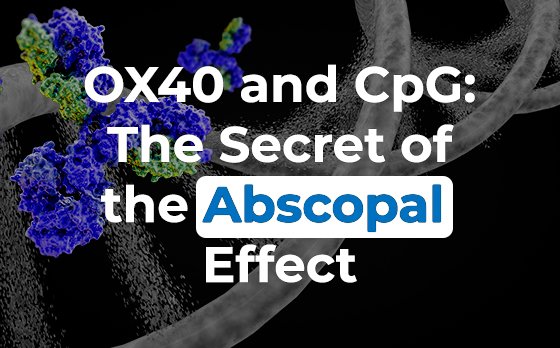Cancer treatment remains a global challenge that drives innovative research to improve therapeutic outcomes. In a recent study published in Cancer Research (2022) by Wan Xing Hong and collaborators, the use of neoadjuvant intratumoral immunotherapy was evaluated in preclinical models, an approach that has shown encouraging results in metastatic tumors when applied prior to surgery.
The concept of this therapy is based on a well-established but still not fully understood idea, the abscopal effect: activating the immune system directly in the tumor microenvironment can trigger systemic immune responses that eliminate both the local tumor and distant metastases. To achieve this, the team employed a combination of a synthetic TLR9 ligand (CpG) and an anti-OX40 antibody. CpG activates innate immune cells, while anti-OX40 stimulates T cells, promoting a robust adaptive immune response.
In this preclinical study, mouse models with highly metastatic colon and breast cancers were used. Tumors were treated with intratumoral injections of CpG and anti-OX40, followed by surgical resection of the primary tumor. The efficacy of the treatment was evaluated by measuring tumor size reduction, the presence of metastases in distant organs, and long-term survival rates.
The study results were conclusive. Mice that received the combination of CpG and anti-OX40 showed effective local tumor control and a significant reduction in pulmonary and hepatic metastases compared to control groups. Additionally, long-term survival rates were remarkably higher in mice treated with the therapeutic combination.
A critical aspect of the study was the timing between treatment and surgery. It was found that a four-day interval between the last injection and tumor resection optimized the outcomes. This finding highlights the importance of carefully planning the timing of surgical intervention in relation to immunotherapy administration.
Another significant finding was the essential role of CD8+ T cells in the efficacy of the therapy. These cells are crucial for destroying cancer cells and mediating a systemic immune response. When CD8+ T cells were experimentally depleted, the benefits of the treatment disappeared, confirming their importance.
Although neoadjuvant intratumoral immunotherapy had already shown potential in previous studies, this work reinforces its application in neoadjuvant scenarios combined with surgery. Furthermore, the authors suggest that combining this approach with immune checkpoint inhibitors, such as anti-PD-1, could further enhance the results.

Figure 1. Mechanism of action of neoadjuvant intratumoral immunotherapy: The combination of CpG and anti-OX40 activates both innate and adaptive immune responses, targeting the primary tumor and inducing systemic effects, including the elimination of secondary metastatic lesions.
While these findings are based on animal models, they provide a solid foundation for the design of future clinical trials in humans. The possibility of treating metastatic cancers with a strategy that minimizes systemic toxicity and enhances immunological efficacy could transform current standards of care.
The study by Wan Xing Hong and his team represents a significant advancement in the field of immuno-oncology. Although much work remains to be done, this approach opens new doors to more effective and less invasive treatments for patients with advanced cancer. Science continues to demonstrate that, with creativity and collaboration, it is possible to transform even the most complex challenges into opportunities to improve human life.
Main Reference:
Hong, W. X., Sagiv-Barfi, I., Czerwinski, D. K., Sallets, A., & Levy, R. (2022). Neoadjuvant Intratumoral Immunotherapy with TLR9 Activation and Anti-OX40 Antibody Eradicates Metastatic Cancer. Cancer research, 82(7), 1396–1408. https://doi.org/10.1158/0008-5472.CAN-21-1382
Other References:
Sagiv-Barfi, I., Czerwinski, D. K., Levy, S., Alam, I. S., Mayer, A. T., Gambhir, S. S., & Levy, R. (2018). Eradication of spontaneous malignancy by local immunotherapy. Science translational medicine, 10(426), eaan4488. https://doi.org/10.1126/scitranslmed.aan4488
Grossman, H. B., Natale, R. B., Tangen, C. M., Speights, V. O., Vogelzang, N. J., Trump, D. L., deVere White, R. W., Sarosdy, M. F., Wood, D. P., Jr, Raghavan, D., & Crawford, E. D. (2003). Neoadjuvant chemotherapy plus cystectomy compared with cystectomy alone for locally advanced bladder cancer. The New England journal of medicine, 349(9), 859–866. https://doi.org/10.1056/NEJMoa022148
von Minckwitz, G., Eidtmann, H., Rezai, M., Fasching, P. A., Tesch, H., Eggemann, H., Schrader, I., Kittel, K., Hanusch, C., Kreienberg, R., Solbach, C., Gerber, B., Jackisch, C., Kunz, G., Blohmer, J. U., Huober, J., Hauschild, M., Fehm, T., Müller, B. M., Denkert, C., … Arbeitsgemeinschaft Gynäkologische Onkologie–Breast Study Groups (2012). Neoadjuvant chemotherapy and bevacizumab for HER2-negative breast cancer. The New England journal of medicine, 366(4), 299–309. https://doi.org/10.1056/NEJMoa1111065


